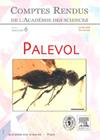New records of buttonquails (Aves, Charadriiformes, Turnicidae) from the Oligocene and Miocene of Europe
IF 1.3
4区 地球科学
Q3 PALEONTOLOGY
引用次数: 0
Abstract
Buttonquails (Turnicidae) are morphologically derived, quail-like members of the avian order Charadriiformes (shorebirds) that live in Old World dry tropical and subtropical open habitats. The morphological disparity between modern buttonquails and other shorebirds is bridged by Paleogene stem-group turnicids, which have a less specialised morphology. However, there is currently a large temporal gap in the fossil record between the earliest European buttonquails (early Oligocene) and the youngest pre-Quaternary records (late Miocene). Here we describe two new taxa from France, based on partial humeri, which we refer to Turnicidae gen. et sp. indet. The oldest record stems from deposits from the latest Oligocene, which are part of the Saint-Gérand-le-Puy fossil sites. The younger record is from the early-middle Miocene fissure filling of Vieux-Collonges. In morphology, both taxa are more similar to early Oligocene species of Turnipax Mayr, 2000 than to crown-group turnicids. Although the fossils are too fragmentary to allow ecomorphological interpretations, paleoenvironmental data suggest that, like Paleogene buttonquails, these taxa departed from the adaptations to open arid environments by modern-type turnicids. Our assessments therefore reinforce previous hypotheses that crown-group turnicids probably did not diversify before the late Miocene, and argue in favour of broader ecological preferences in stem-group turnicids.欧洲渐新世和中新世钮扣鹌鹑的新记录(鸟类,charadriformes, Turnicidae)
Buttonquails (Turnicidae)是一种形态衍生的,类似于鹌鹑的鸟目Charadriiformes(滨鸟)成员,生活在旧大陆干燥的热带和亚热带开放栖息地。现代鹌鹑和其他滨鸟之间的形态差异由古近系茎群turnicids弥补,它们的形态不那么专门化。然而,目前欧洲最早的纽扣鹌鹑化石记录(早渐新世)与最年轻的前第四纪记录(晚中新世)之间存在较大的时间差距。本文以部分肱骨为基础,描述了两个法国新分类群Turnicidae gen. et sp. indet。最古老的记录来自最近渐新世的沉积物,它是saint - gsamrand -le- puy化石遗址的一部分。较年轻的记录来自中新世早中期的Vieux-Collonges裂缝充填。在形态上,这两个类群更接近早渐新世的Turnipax Mayr, 2000,而不是冠群turnicids。尽管这些化石太过碎片化,无法进行生态形态学解释,但古环境数据表明,像古近纪的纽扣鹌鹑一样,这些分类群偏离了适应开放干旱环境的现代型turnicids。因此,我们的评估强化了先前的假设,即冠状群turnicids可能在晚中新世之前没有多样化,并支持茎状群turnicids更广泛的生态偏好。
本文章由计算机程序翻译,如有差异,请以英文原文为准。
求助全文
约1分钟内获得全文
求助全文
来源期刊

Comptes Rendus Palevol
地学-古生物学
CiteScore
2.10
自引率
0.00%
发文量
39
审稿时长
17.6 weeks
期刊介绍:
Comptes Rendus Palevol is a fully electronic and peer-reviewed journal, with a continuous publication stream, devoted to palaeontology, prehistory and evolutionary sciences. It publishes original research results, in French or English, in the following domains: systematic and human palaeontology, prehistory, evolutionary biology and macroevolution, and history of sciences. Thematic issues may also be published under the responsibility of a guest editor. All articles published in Comptes Rendus Palevol are compliant with the different nomenclatural codes. A copyright assignment will be signed by the authors before publication.
 求助内容:
求助内容: 应助结果提醒方式:
应助结果提醒方式:


